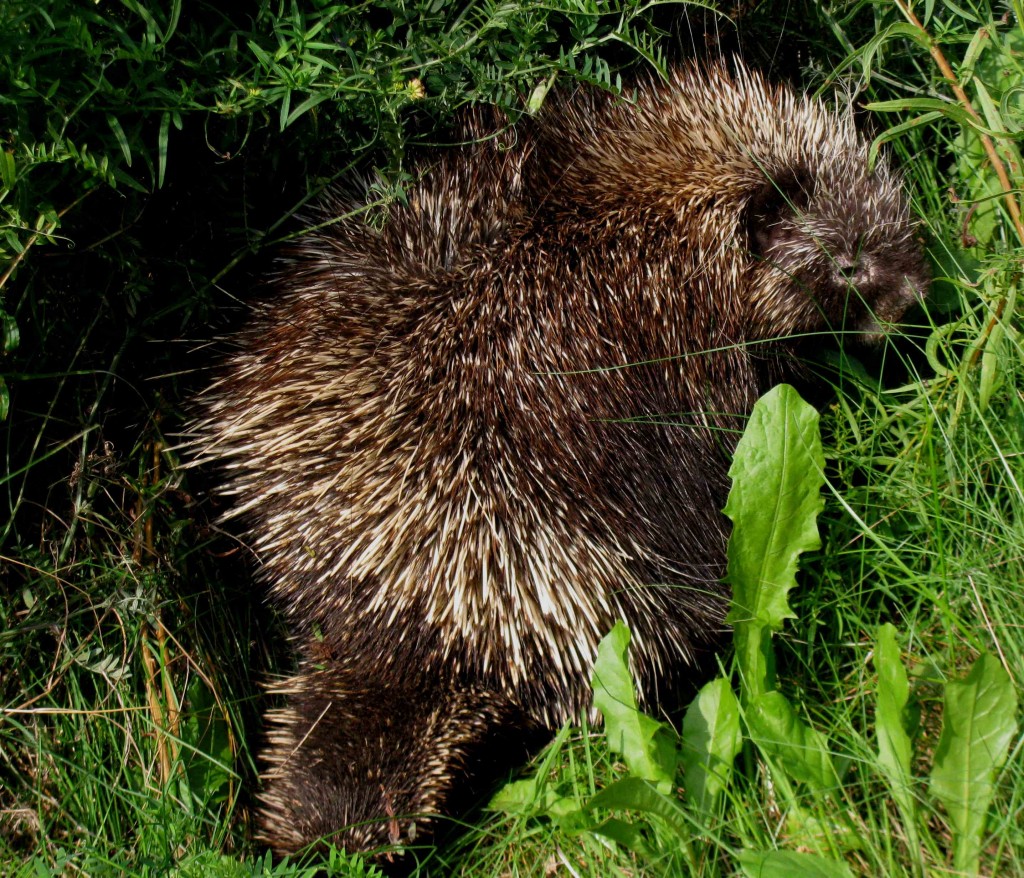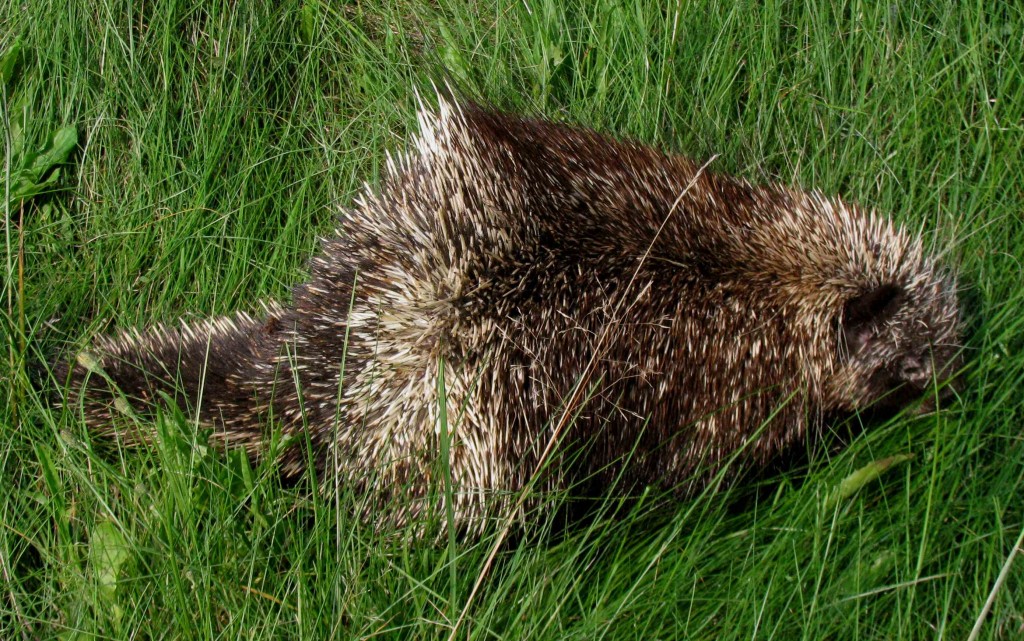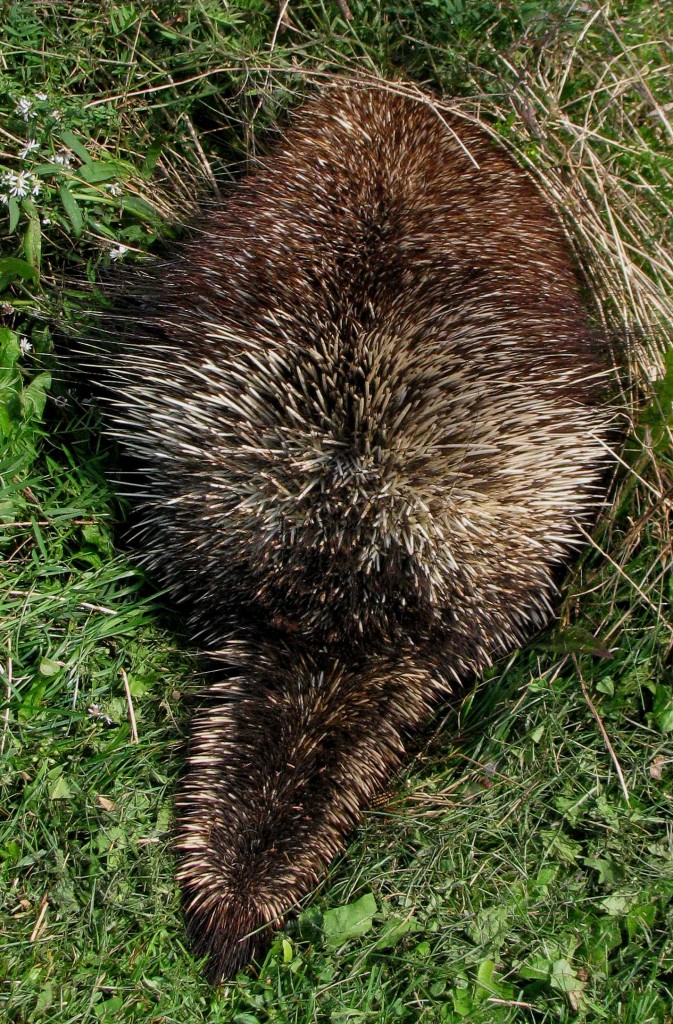
Porcupine (© Magi Nams)
Erithezon dorsatum. Quill pig. Porky. This morning, I looked out my kitchen window and once again saw the large porcupine which, within the past week, I’ve frequently seen trundling across our lawn or grazing on tall, lush grass growing where Vilis had earlier pastured our chickens. Moving slowly, its back hunched into a spiky mound, the porky rummaged around our fire pit. Yesterday, it rummaged around the pig trough.
During the summer, either this porcupine or another trashed the crown of our young Bartlett pear tree by chewing and tearing off branches. Vilis and I confirmed the culprit species’ identity by studying the lopped-off branch ends and the oval droppings at the base of the tree. Definitely porcupine. We protected that tree from further damage by wrapping the trunk with slippery, hard plastic. However, our yard contains thirteen other young fruit trees in which we have invested a decent sum of money and many hours of TLC. Peaches. Apples. Plums. Cherries. More pears.

Porcupine (© Magi Nams)
Each time I saw the porcupine, I cringed a little more at the thought of what its formidable rodent teeth might do to those vulnerable and valuable trees. It seemed innocuous, waddling its way here and there and leaving no sign of recent bark or branch chewing. (During the summer, porcupines graze on grasses and other plants as well as shrub leaves. Bark, buds, and sapwood are their winter staples.1) Nonetheless, I decided the quill pig had to go.
I told Vilis I wanted to catch the porcupine and transport it elsewhere. He suggested I use a tarp to bundle it up. Thus, this morning when I saw the porcupine, I grabbed a blue tarpaulin out of the basement, brought the dog inside (she’s brilliant – never bothers with porkies), and donned protective gear – rubber boots, a sturdy jacket, and thick leather mittens lined with sheepskin.
If you’ve ever removed porcupine quills from the face and mouth of a dog (Vilis and I did this several times with a different dog), you’ll know that the quills are extremely sharp and possess tiny, backward-facing barbs at the business end. Having heard the howls of pain and seen blood spurt out of our dog’s muzzle upon removal of said quills, I had no desire to put myself in the position of having to yank them out of me.
Well, the porky and I had quite a little dance. It shuffled away from me. I pursued it. It turned and swung its stiff, quill-armoured tail back and forth. I threw the tarp over it. It escaped. I went after it again. It escaped again. Hit with a brainwave, I positioned the tarp edge in front of the beast and folded it over that prickly back. As good fortune would have it, the porcupine lumbered straight onto the tarp. Voila! Success! I bundled the porky in several layers of tarp (its face appeared through a gap at one point) and gingerly lifted the wriggling bundle.

Porcupine in Defensive Posture ( Magi Nams)
I popped the porcupine into the back of our Ford Ranger and drove to the end of our 800-metre lane to release it into more natural habitat than my yard. Before I reached the release site, my captive had escaped from the tarp and was moving agitatedly about in the truck box. When I stopped the truck and exited it, the quilly one rose onto its haunches and stared at me with its nearsighted eyes. Then it shoved its nose into a corner of the truck box and refused to budge, exposing only its spiky back and that threatening tail. (This is classic porcupine defensive behaviour, if you replace the truck box corner with a more natural nook or crevice.)
After an unsuccessful attempt to repeat my tarp-capture strategy, I had another brainwave. I opened the endgate and propped a large, dead branch between the ground and endgate. I managed to get the porky turned around by sliding a flat piece of metal between its face and the truck box corner. As soon as it saw the gate to freedom as it were, it rushed to the branch and began climbing down it. The branch rolled, and the porky fell off it onto the ground, landing on its back and exposing a hairy belly completely lacking quills. (Fishers hunt porcupines by biting their faces to kill or immobilize them, and then flipping them over to expose that unprotected belly.1) Rather clumsily, the porcupine righted itself and trundled off into the roadside vegetation.
The truck box was littered with quills. The tarp and one mitten were impaled with quills. I, however, was not.
Reference:
1. Adrian Forsyth. Mammals of the Canadian Wild. 1985. Camden House Publishing Ltd., Camden East, ON, pp. 224, 226.


